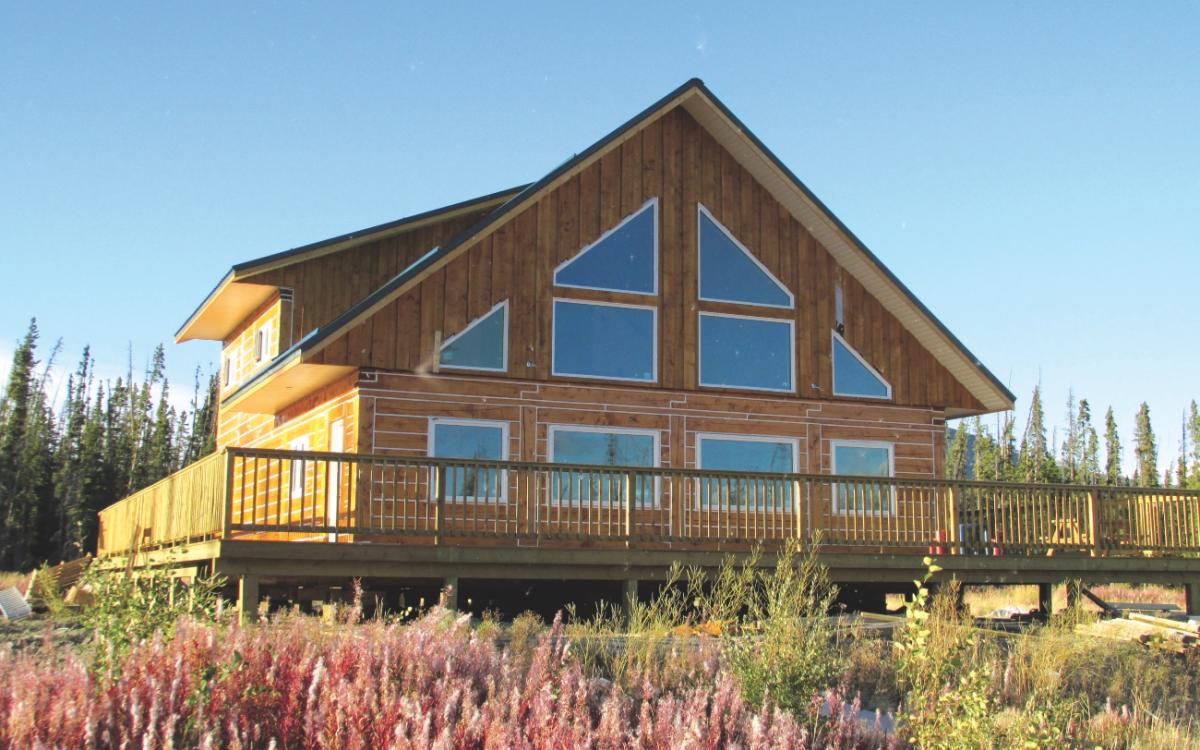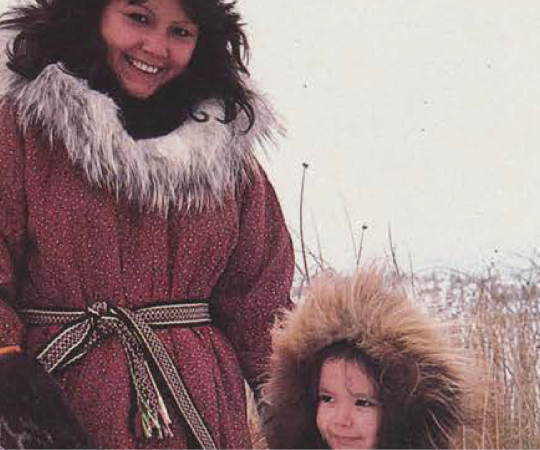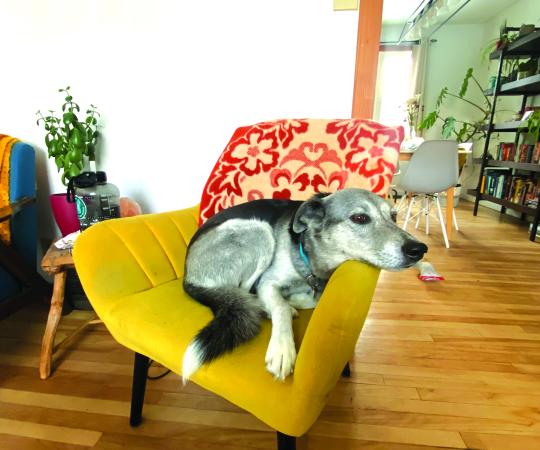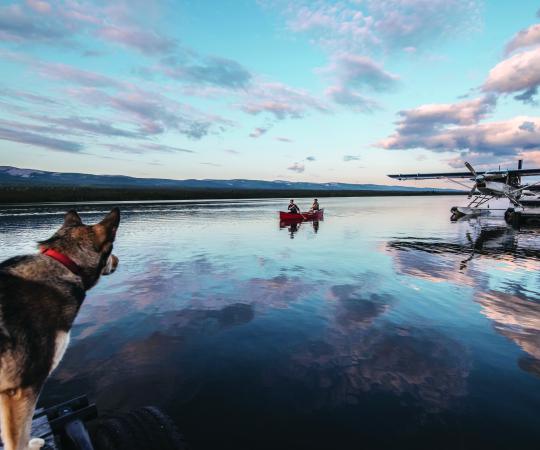When Jane Dragon looks around her log home, her mind floods with memories of her late-husband and the family they nurtured there together. Dozens of photos of her children and grandchildren hang from the rounded log walls, alongside taxidermied animals from her days
as a trapper.
Dragon, 81, and her husband David built the 30-by-30-foot house in Fort Smith, NWT with their own hands back in the 1960s. The couple dreamed of living in a log house long before they began building it. She recalls the years spent collecting rows of timber from the banks of the Salt River, peeling the logs, and stacking them to make the very structure she sits in now.
The house took 10 years to complete, using timber more readily accessible than other construction materials that would have been shipped in. “My husband didn’t even have a credit card,” she says. “It took a long time because we didn’t want to borrow money.”
When it was finally time to move in for good, the couple had six children in tow. They raised their family in the single-level home. “I’ve been in the house for 51 years now,” says the Dene elder, seated by one of the wide windows that lets generous natural light shine in. “It’s special because we built it ourselves. I love my house.”
Log houses like Dragon’s were quite common in the North a century ago, with industrious Northerners constructing their homes with the most obvious and abundant local building material around. But as supply routes were established and then improved, more conventional homes began to crop up in growing towns and cities. Today, Dragon’s home stands out among the apartment buildings and multi-level, single-detached homes that surround it.
Yet, hidden in sleepy neighborhood cul de sacs or busy city centres, you’ll still spot the odd log home. And while some have been around for generations, others are relatively recent additions—erected by owners who pine for the rustic charm of a home from a bygone era.

David Loeks thinks there’s something special about living in a log home. “When you’re in a solid wood home, it has a way different feel than a synthetic house does,” he says. “There is a value for nature and naturalness, and a sense of gravitating toward authentic things as opposed to contrived things.”
Loeks, who lives just north of Whitehorse, has dedicated more than a decade of his life to refining rows of timber, which he then bleaches, stains and ships across Canada. Heartland Timber, a business he co-owns, creates easy-to-assemble log houses, letting clients choose a floor plan and customize it however they want. The structures can range from mansions and swanky chalets to one-room cabins or log saunas. Heartland ships building materials to customers, who put together the numbered logs themselves, needing only to build their own floors and roofs. “It’s very much like Lego,” Loeks explains. “We employ the principle of interchangeable parts: all wall timbers and posts are identical to each other; the beams are identical.”
Heartland sells roughly 25 kits per year, shipping them as far away as Montana, but most often to customers across B.C., the NWT, and the Yukon. (Heartland is one of several Northern companies in this market. Northwood Log Homes, out of Fort Smith, and Watson Log Homes, in Haines Junction, Yukon, also sell and ship log home kits.)
Loeks says his customers are looking for something unique. “They sometimes choose log houses for nostalgia or they have an interest in heritage and tradition,” he says. “It’s often a lot of people who have never lived in a log house, but—with either a newfound sense of identity from having moved to the North or having grown up here—they somehow think a log house is what you ought to be in.”
Loeks chose log house living for himself back in 1990 because he felt it brought him closer to nature. His home sits atop a rocky cliff that overlooks a sprawling forest landscape. Large windows allow the light to flood into the second floor. This is where Loeks built the living room and kitchen—“where the view is and the breeze is.”
Although the view’s a little different in Yellowknife’s Forrest Drive neighbourhood, Jim Woodruff shares Loeks appreciation for log homes.
When a 2,000-square-foot log house went up for sale in 2012, Woodruff jumped at the opportunity. Built in 1982 by Lorne and Joan Schollar, the two-floor log house needed some work, but Woodruff saw its potential. Since moving in, he and his wife Faith have converted three upstairs bedrooms into two rooms with ensuite bathrooms, added another bedroom to the lower floor, and touched up the plumbing, electrical and heating.
And then there was the sanding. Woodruff estimates it took him more than 500 hours to completely buff up the exterior—sanding down each pine log until it was white, scrubbing them and then giving them two coats of varnish. Despite the near decade it’s taken to upgrade the house so far, it’s been worth it. “Pretty much everyone in the city recognizes it,” he says. “All I have to do is say I live in the log house on Forrest Drive and people know which one I’m talking about.”
It’s certainly easy to spot, with its tall, peaked roof and double balconies stretching across the front of each level. The Woodruffs have plans to run a B&B. (‘Log Haven’ is a name they are throwing around.) And although it sits in a residential neighbourhood in the capital city, Woodruff’s home reminds him of another time. “It goes with the environment, landscape and history of the North.”
Unlike the log houses going up today, many of the dwellings built a century ago were done in haste, as shelters against the cold. For that reason, Nansen Murray, Historic Sites Conservation Planner with the Yukon Government, says they weren’t made to stand the test of time.
“Often they didn’t have a foundation—they’re just still logs lying on the ground,” he says, noting most of these structures weren’t built with water-tight roofs and could be quite drafty. “[The builders] might have been out in the woods and had to throw up a cabin very quickly, only expecting it to last that winter or maybe a few seasons, so there’s a very temporary feel to a lot of the cabins.”
Loeks says many settlers who came north to both the Yukon and NWT weren’t necessarily the most experienced builders. “They used moss and whatever else they could find to stop up the cracks,” he says. “Some might not peel logs and, ten years later, the house would fall apart because the insects were in the logs and were busily eating them away.”
Through the Klondike Gold Rush, Murray says six sawmills opened around Dawson City and more timber frame houses began to replace log homes. By the end of the Second World War, modern homes became the norm, as older log cabins either deteriorated or went up in flames.
“Fires were a very common occurrence,” Murray says. The 1905 Whitehorse fire, for example, devastated downtown and many of the most important buildings were destroyed. “Very few buildings survived.”
Though log homes have all but vanished in many Northern communities, they are thriving in others. When Kyle Tutcho decided to tackle Colville Lake, NWT’s housing shortage, he leaned on a local tradition and focused on log homes. In 2015, Tutcho was ready to live on his own, but with a lack of housing in the settlement of 130 people—located 50 kilometres north of the Arctic Circle—his options were limited.
Using skills he acquired through a log house-building course in B.C., Tutcho got to work collecting 80 logs from just outside of town. The NWT Housing Corporation helped supply construction materials in the fly-in only community and later provided $264,000 to help Tutcho and others build additional log structures to create more local affordable housing. This summer, crews were set to build four new houses in town. Log homes, once a part of Colville Lake’s history, are now an exciting part of its future.
To many, log homes revive imagery of trappers and gold seekers battening down for a long winter. Others associate them with a feeling of being closer to nature. To Dragon, they conjure up warm memories of comfort and family. And to a growing number of Northerners, a log house is simply synonymous with home.










